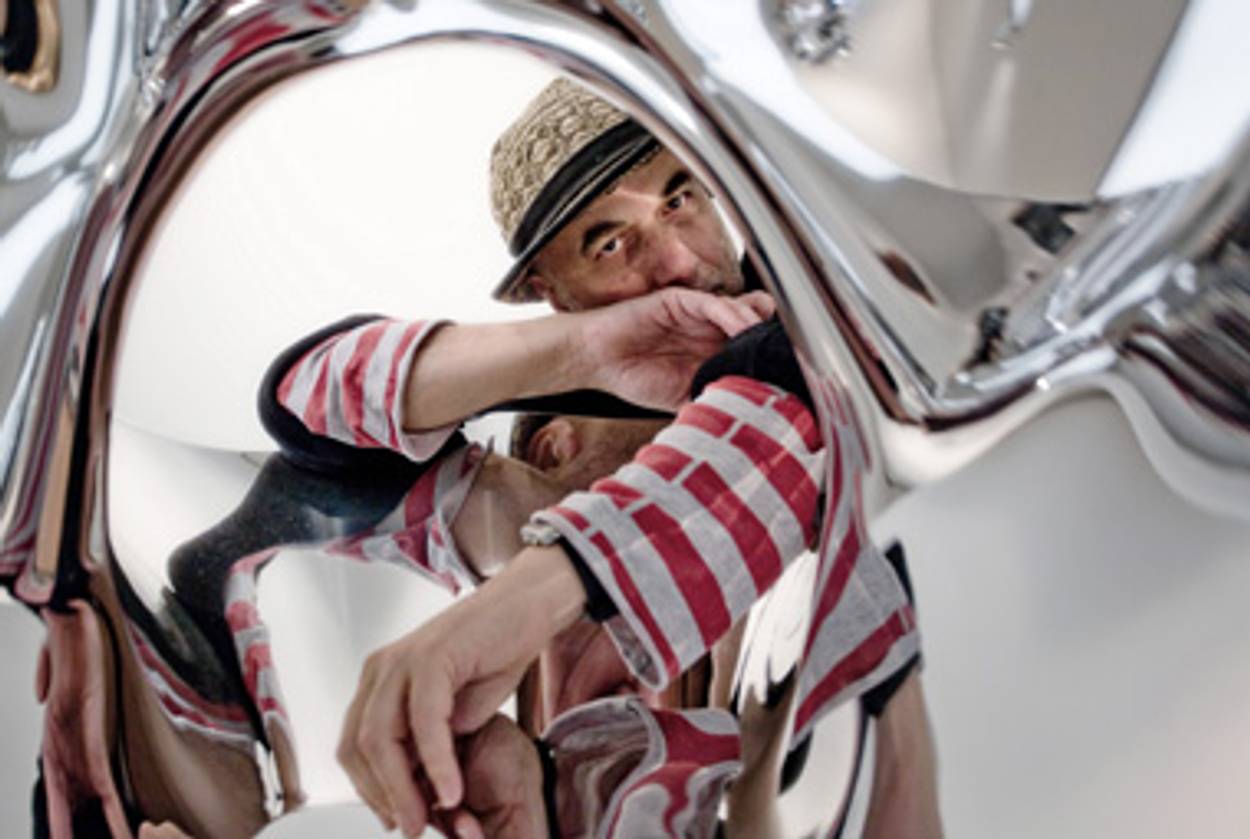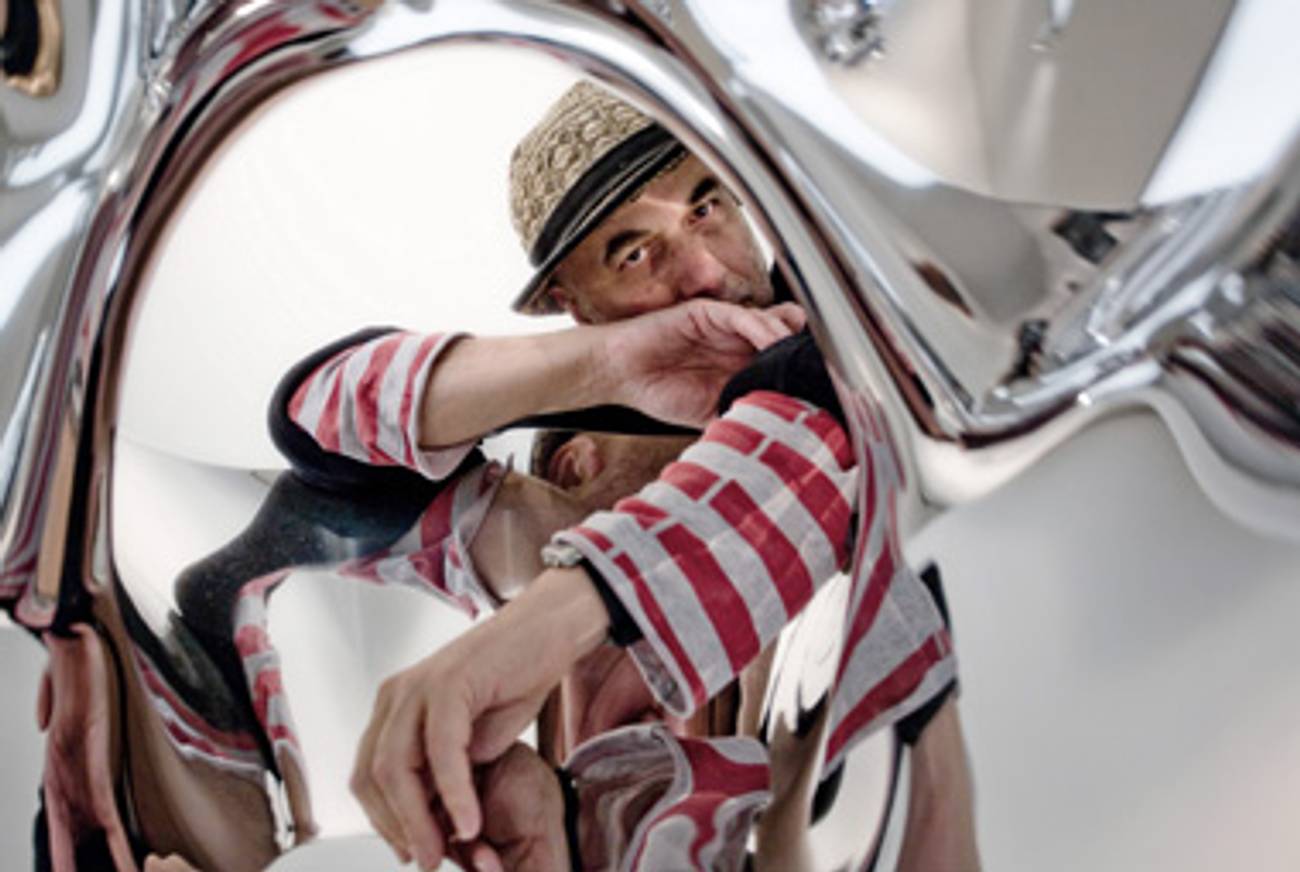Design Without Borders
The twisting, shimmering, and unpredictable universe of Ron Arad




The irreverent design superstar Ron Arad eludes easy categorization. Trained as an architect in London after studying at Jerusalem’s Bezalel Academy of Art and Design, he is internationally recognized primarily for innovative objects, whether limited-edition sculptural furniture or industrial mass productions. Even his nationality doesn’t lend itself to neat classification. Though born in Tel Aviv in 1951, he has lived in England since the mid-1970s and is usually identified as “British, born Israel.” Apart from some trademarks—an affinity for curves, optical illusions, and rich textures—Arad’s only constant is his endless experimentation with materials, techniques, and forms.
This intrepid sensibility is celebrated in the current retrospective of Arad’s work (and alluded to in the catchy title, No Discipline), at the Museum of Modern Art in New York. The centerpiece, Cage sans Frontières (Cage without Borders), is a massive Corten steel structure lined with stainless steel shelves that Arad created to display most of the pieces in the show. Draped with gray gauze and looped like a twisted rubber band so that the translucent side is at points external and at others internal, the installation is an awesome work in its own right, encapsulating Arad’s predilection for manipulating space and perception. But as critics have noted, MoMA’s placement of numerous objects on high shelves and against surrounding walls, coupled with dim atmospheric lighting, doesn’t make for optimum viewing. (At the Pompidou Centre in Paris, where the show debuted last fall, works were sublimely sprawled across a life-size reproduction of the foyer of the Tel Aviv Opera, Arad’s first commission, and along a spiraling white wall illuminated with phosphorescent, bulbous shadows.)
Still, there’s no denying the sheer punch of Arad’s output. Bravura pieces that launched his career, like the 1981 Rover Chair, made by fusing a leather car seat found in a junkyard with a tubular steel base, may amuse more than amaze. But the same can’t be said for ingenious creations like the 1986 Well Tempered Chair, modeled after four sheets of paper simply looped and attached. The clunky wing nuts and cheeky name remind us that if the bolts were removed, the elastic, tempered steel would spring right back to its original shape, and while the sleek mirrored surface seems forbidding, this re-imagined, bouncy club chair is in fact extremely comfortable. In almost every piece, Arad dances between these two competing, apparently equally valid, notions: on the one hand, what you see is what you get; on the other, perceptions can be misleading.
The MoMA show is also eye-opening in its eclectic juxtapositions, enabling viewers to see, as Arad puts it, “objects that have never met before, like siblings separated at birth.” The inclusion of architecture is particularly welcome, although the small white models (even with accompanying videos) don’t vividly convey the dynamism of these projects. For while Arad has expressed ambivalence about his first profession, with its reliance on clients, budgetary constraints, and long lag times, his firm, Ron Arad Associates, recently spawned a branch focusing on architecture, and his essential ideas play out on a grand scale in these more complex creations.
Notably, four of the nine projects represented with dioramas at MoMA are in Arad’s native country: the sinuous, dramatic interior of the Tel Aviv Opera, opened in 1994; the National Design Museum in Holon, one of Arad’s first two entirely new buildings (the other being a mall in Belgium), both nearing completion; the stalled but formidable public sculpture for Zion Square in Jerusalem; and a luxury apartment building on Tel Aviv’s Hayarkon Street scheduled to break ground this January. (The firm is also in negotiation on a 1200-seat concert hall in Israel, though it couldn’t share details at press time.) Combined, these plans not only showcase Arad’s masterful blending of function and form, technology and intuition, but also signal a bright spot for Israeli architecture.
The Holon museum, part of a cultural renewal program for the central coastal city, ambitiously aims to position Israel as a global center for design. (Off to a good start, the building graces the cover of a recent tome on Arad’s architecture.) Originally scheduled to open last summer and then this past spring, the relatively small but intricate structure is now slated for an inaugural exhibition, “Only Now,” in February. The show will present more than 100 objects that “collectively tell the story of the practice, consumption and cultural impact of contemporary product design,” according to the institution’s CEO Alon Sapan, noting that Arad’s “iconic building itself stands as the museum’s first design object.”
As with the Cage at MoMA, a multifaceted curve is the defining feature—here taking the form of a sinuous shell of Corten steel in weathering shades of rust, evoking local topography (Holon has at its root the Hebrew word for sand), that meanders in, out and around the museum’s core. Asa Bruno, the chief architect on the project, recalls that the firm modified its original, voluminous design to “create a signature building” on an “economy of means.” This was accomplished by fusing five relatively efficient sectional bands in gradated browns and reds that maintain fluidity while giving the façade a coherent look. Beyond supporting rectangular internal spaces that have no structural beams (to provide optimal exhibition space)—and, in the process, exploiting the tension between the rigid inner and curvaceous outer components to great effect—this frame provides visitors an experiential route through the museum and nominal shading as it splays apart midair and reunites at both ends.
Although Arad had greater artistic freedom, context is even more consequential in the Zion Square sculpture—really a large-scale installation—commissioned in 2006 as part of a redevelopment of Jerusalem’s main east-west artery, Jaffa Road. Approved by the municipality and fully funded, it was shelved by former Mayor Uri Lupolianski, though there is still faint hope it may be revived under the new administration of Nir Barkat. The canopy-like structure, suggestive of an imposing dinosaur skeleton, is made of the same coppery Corten as the Holon museum but crowned with a honeycomb of 400-odd hollow cubes lined with mirror-polished stainless steel. As the sun passes above and seasons change, shifting shadows play against the ground below. So while, viewed from the outside, it is, according to Bruno, “intentionally angular and slightly aggressive,” when you stand underneath it, you experience a kaleidoscope of airy sky and ricocheted surroundings. The “duality of threatening and optimistic,” as Bruno describes it, acknowledges the turbulent history of the plaza, the site of numerous suicide bombings and demonstrations, as well as its significance as a social gathering place in the heart of the modern city.
The Tel Aviv luxury apartment building may not be nearly as evocative, but it is the latest sign that advances in Israeli architecture are on the horizon. Although the country has a strong international reputation for design, it hasn’t produced much significant modern architecture. A wave of activity is slowly changing that: Santiago Calatrava’s bridges in Jerusalem (2008) and Petach Tikva (2005); I.M. Pei’s Bank Leumi headquarters in Tel Aviv; planned residential towers by Richard Meier and Daniel Libeskind and a Center for Peace by Massimiliano and Dorina Fuksas in Tel Aviv; and Frank Gehry’s proposal for a Jerusalem branch of the Simon Wiesenthal Center. But Arad is the only native son working at this elite level. His Holon Design Museum will put Israel firmly on the map while his continuing experiments on the global stage will likely bring further prestige to the country, even if Arad, ever difficult to pin down, would never classify himself as strictly “Israeli.”
Jeannie Rosenfeld, a Tablet Magazine contributing editor, writes about fine and decorative art.
Jeannie Rosenfeld, a Tablet Magazine contributing editor, writes about fine and decorative art.